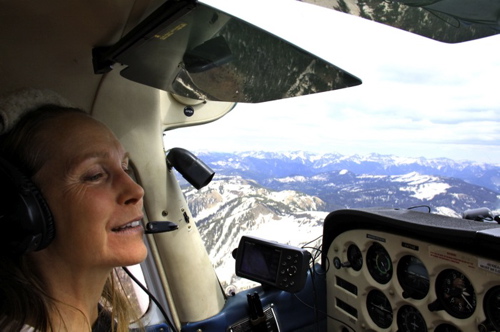Updated Thursday, July 29
I just love it when extremely brilliant women connect and get the job done. I also love the fact that being a writer gives me a good reason to be the proverbial fly on the wall and witness their dedication, perseverance, and tenacity. New Orleans film producer Bess Carrick wanted to see what the Gulf of Mexico looked like in the 48 miles between the tip of the Mississippi Delta and the blown Macondo wellhead for a series she is producing called The Barataria Chronicles. She had met NASA pilot, Caltech graduate and theoretical physicist Dr. Bonny Schumaker, and convinced Bonny to take her on a fly-by on Monday. This was 24 hours before the mainstream talking heads of all political stripes were declaring that only one barrel of oil had been skimmed from the Gulf on Tuesday, so it looked pretty much as if the crisis were over.
But is it?
The oil flowed mercilessly for 86 days until July 15, dumping 200 million gallons of Louisiana crude into the Gulf of Mexico. SkyTruth, the website that has accurately depicted the size and scope of the river of oil since the days when BP was maintaining a paltry 1000 barrels per day, has a nifty analysis and a couple of good caveats.
Oil floating at the ocean's surface has a limited lifespan - it's been collected and destroyed by skimming, booms, chemical dispersants, evaporation, photolysis, biodegradation - and took a beating from wind and waves when tropical depression Bonnie blew through over the weekend. If the well stays plugged until the static-kill and bottom-kill efforts permanently plug it with cement, then the remaining fragments of slick should disappear within days.
The big question remains and SkyTruth asked it. All of those 200 million gallons did not vanish. How much oil can't be seen with satellite images? How much oil is buried in beach sands, embedded in marshes, is still dispersed in the water column or is lying on the sea floor?
The Washington Post suggested that while the feds
have been fixated on the Natural Resources Damages Assessment (NRDA)
process prescribed by the Oil Pollution Act of 1990, "BP has been
engaging academic scientists for its NRDA defense. Billions of dollars
are at stake, so litigation is likely to go on for years."
Politicians, BP and the Coast Guard "sock puppets" would sure be happy if those 200
million gallons just went away.
Carrick wanted to see for herself, and so she did, presenting a snapshot of one afternoon that speaks volumes about the necessity to keep up with the research and keep all eyes on the Gulf before research succumbs to litigation.
Carrick is admittedly a producer and not an editor, but she managed to learn Final Cut Pro software in three weeks (no small task) and set off to chronicle Barataria Bay. She is no newbie to production, and her most recent full-length, award-winning documentary, "Lindy Boggs: Steel and Velvet" explores the life of journalist Cokie Robert's mother, Ambassador Lindy Boggs. The documentary won a Telly award and currently is in national distribution on PBS. Carrick also happens to have built a nature retreat on the edge of the wilderness in Mississippi, among other things. But that is another story.
NASA pilot Schumaker is Sea Shepherd's liaison for Operation Gulf Rescue, and has been in the Gulf since the early days of the oil disaster. She has been flying with NASA colleagues doing remote sensing and spectral imaging and uses her commercial pilot's license as credentialing collateral to fly government officials, journalists and people like Carrick.
Schumaker is also the founder of the non-profit On the Wings of Care, dedicated to promoting the welfare of domestic animals and wildlife and their habitats by helping with searches, rescues, transports, rehabilitation, and scientific research. There is spectacular photography of what remains of the Deepwater Horizon Macondo wellhead site, known in pilot lingo as "The Source" on the website.

Schumaker was able to take the cameras below the 3,000 feet general aviation exclusion zone and get up close to the Gulf. You can track her flights here. Although she saw less "observable oil" on the surface, something else was also lacking. Other than a school of golden rays, the normal sea life, such as dolphins were largely absent. Where did they go, and why? Did they leave the contaminated zone on their own, or are their bodies lying unnoticed, undocumented, and ultimately abandoned on the sea floor.
No one knows.
Beleaguered Raccoon Island remains in peril, confirming reports of biologist Drew Wheelan and photographer Jerry Moran.
According to Wheelan:
Raccoon Island, one of the most densely populated islands with birds in the entire state was left with one layer of deflective inner harbor type boom, which was completely useless against the waves and the wind from a storm in early July. As of last Friday, day 94, this boom was still piled high up on the beach, having been washed ashore with the same oil that drenched a large number of birds, an event that was brought to light by Cornell University biologists studying the colony.
Carrick videoed hundreds of feet of oiled orange deflective boom that was piled on breakwaters, unattended, and birds were perching in the mess.
(Note: You can view every article as one long page if you sign up as an Advocate Member, or higher).





